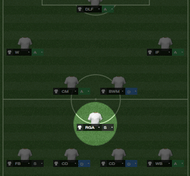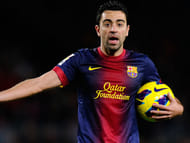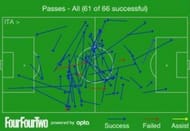Midfielders form the most important part of any team in football. The midfield works as the connectivity between the defence and the attack, quite literally too. It acts as an anchor that holds the entire squad together.
What differentiates an average midfielder from a good one is his ability to control the flow of the game through his passing, ability to tackle, and the vision to find his teammates through long balls. But not all midfielders have the aforementioned attributes; some dictate the play of their team by starting from deep in their own halves. These are who are called a regista or a deep-lying play maker.
Regista in Italian means ‘director.’ It actually means the one who directs, who dictates the offensive play of the team. A regista is not the one who would run around the pitch vying for the ball, but it’s someone who would start his move by lying deep in his own half just in front of the centre-backs and finding his teammates with balls that would be difficult to spot even on a TV screen. Such is the elegance of the regista.
The player role regista would typically be the #8 shirt position. It’s a very popular position in Italian football with Andrea Pirlo being the most famous servant of this player role. Most recently, 21-year-old Marco Verratti has made his name as one of the most promising registas playing for Paris Saint-Germain. The registas are players that remain in the midfield area and control the game through their passing, often known as ‘midfield generals’ when combined with leadership and organisation skills. They are all excellent, accurate long-range passers of the ball with great vision and can dictate the play. They tend to remain in position and leave the goal scoring to others. Their skills on the ball, however, often mean that they score from free kicks or long range shots.
They have always been an influential part of any team for European success. In 2005, Liverpool had a regista in the form of the Spaniard Xabi Alonso, who orchestrated one of the best comebacks in the history of European football when Liverpool came back from three goals down at half-time to draw level and then win the Champions League in a penalty shootout. Two years later, AC Milan avenged that defeat in Istanbul by beating Liverpool with the help of a regista of their own, Andrea Pirlo, who got transformed from a trequartista (attacking midfielder) by Carlo Ancelloti.
The importance of the regista lay even further as Xavi Hernandez won two Champions League finals in 2009 (Rome) and 2011 (Wembley) performing the task of the deep-lying playmaker in what was arguably one of the best sides to have graced the sport.
Italy won the 2006 World Cup using a regista (Pirlo), Spain won Euro 2008 and World Cup 2010 using a regista (Xavi) and both Italy and Spain reached the final of Euro 2012 using the regista. Furthermore between 2007 and 2012, 5 out of the 6 Champions League winners used a regista. For Manchester United and Chelsea, champions in 2008 and 2012 respectively, Paul Scholes and Frank Lampard who might not have been “traditional” registas played a very similar role for their teams.
Andrea Pirlo is the paradigm of the regista. The Juventus player has for the better part of a decade defined and embodied the role much in the same manner as Claude Makélelé defined the defensive midfielder position. The picture below displays every pass which Pirlo made against Germany in their 2-1 semi-final victory at Euro 2012. With 61 out of 66 passes being successful, the midfielder achieved an admirable completion rate of 92.42%.
The absence of a regista has been a problem for many teams. But it has been the most evident in Manchester United since 2009 after Owen Hargreaves and Paul Scholes seemed to have solved their midfield quandary by leading them to the Champions League win in Moscow in 2008. The constant injuries to Hargreaves were unfortunate and the aging legs of Scholes barely helped, though neither were a traditional regista. Since then, United have appeared in two finals in 2009 and 2011, losing both to Barcelona, which highlights the absence of a true midfield magician a.k.a. a regista.
The regista is not usually known for his tackling prowess, though, as these players tend to come from deep in their own halves and possess remarkable passing skills. To help support with the defensive duties, he generally has a defensive midfielder beside him – like Sami Khedira supports Xabi Alonso at Real Madrid – to form a ‘double pivot.’
From a tactical viewpoint, the success of a regista lies on building a team around him. Teammates should be aware and, in fact, will be instructed to provide him with the ball at every opportunity. The attacking moves will originate from the regista who will remain at the pivot of every attacking play. In essence, the regista becomes the focal point as well as the organisational mastermind of a team.
Not all the best teams in the world use a regista. Bayern Munich, for all their attacking prowess, accomplished a treble last season without a regista in their ranks. Inter Milan, who won the treble in 2010, did not use a regista, but instead relied on the traditional attacking central midfield play maker in Wesley Sneijder.
However, the facts don’t lie. The past has given us so many instances of teams getting a lot more stability when there’s a regista to orchestrate their play. Hence, not only the teams with rich history, but also the relatively smaller teams in various leagues of Europe are trying to accommodate a regista in their squads these days. The regista is becoming one of the most talked about topic in modern day football, and it could well be a position which will see some of the the most sought-after players in the years to come.



